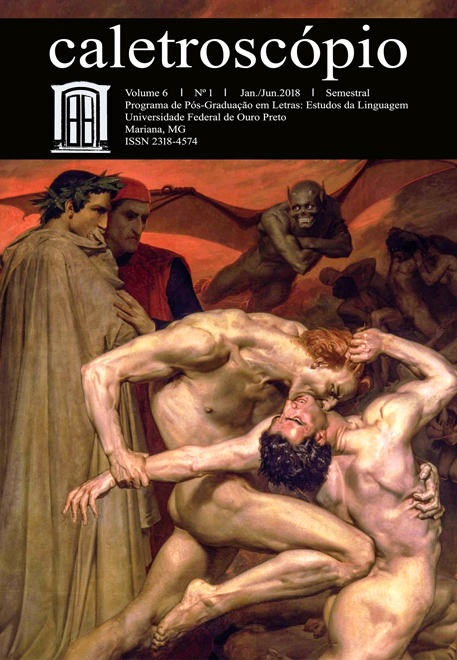The portuguese dactylic hexameter: an overview
Abstract
This paper investigates the practice of Lusophone translators of employing the Portuguese dactylic hexameter, a practice that dates back to the eighteenth century. A key figure was Carlos Alberto Nunes, whose practice in the middle of the twentieth century differs a little from that of his predecessors (such as Nolasco da Cuinha and Júlio de Castilho, among others), as he avoids the substitution of trochees with dactyls and also changes his way of making the caesura. It can be argued that Nunes anticipated the twenty-first century trend of translating ancient epic in vernacular hexameters. His translations influenced Brazilian poetry in the fifties and continue to provide inspiration to contemporary researchers and translators of classical poetry, not only epic, but also elegy and lyric, in Brazil.
Downloads
References
Bernhardt-Kabisch, Ernest 2003. “’When Klopstock England Defied’: Coleridge, Southey, and the German/English Hexameter”. Comparative Literature, 55, No. 2, Spring, 130-163.
Brunet, Phillipe (ed.), 2014. Anabases, 20. (“Homère en héxametres”. Rencontre internationale de traducteurs. Paris, 16 mars 2012. Réfectoire des Cordeliers. 7e edition des Dionysies).
Carducci, Giosuè. l88l. La poesia barbara nei secoli XV e XVI. Bologna: Nicola Zanichelli, Libraio, Editore, Tipografo.
Castilho, A. F. de 1874. Tratado de metrificação portugueza seguido de considerações sobre a declamação e a poetica. 4a ed. revista e augmentada. Porto: Livraria Moré-Editora.
Cunha, J. A. da 2001. Obra literária. Vol. I. Edição de Maria Luísa Malato Borralho e Cristina Alexandra Marinho. Porto: Campo das Letras.
Faustino, Mário 2003. “Vitor Hugo brasileiro”. In Boaventura, Maria Eugênia (ed.), Mário Faustino: de Anchieta aos Concretos. São Paulo: Companhia das Letras, 186-202.
France, Peter & Gillespie, Stuart (eds.), The Oxford history of literary translation in English. Vol. 1, To 1550, ed. by Roger Ellis, 2008. Vol 2, 1550–1660, ed. by Gordon Braden, Robert Cummings and Theo Hermans, 2010. Vol. 3, 1660–1790, ed. by Stuart Gillespie and David Hopkins, 2005. Vol 4, 1790–1900, ed. by Peter France and Kenneth Haynes, 2006. Vol 5, 1900–2000, ed. by Lawrence Venuti, 2014.
Gonçalves, R. T. et alii 2011. “Uma tradução coletiva das Metamorfoses 10.1-297 com versos hexamétricos de Carlos Alberto Nunes”. Scientia Traductionis, 10, 110-132.
Homer 2002. The Odyssey. Translated by Rodney Merrill. Michigan: University Press.
Homer 2007. The Iliad. Translated by Rodney Merrill. Michigan: University Press.
Homère 2010. L'Iliade. Traduction de Philippe Brunet. Paris: Éditions du Seuil.
Homero 1943. Odisseia. Traduzida do grego no metro original por Carlos Alberto Nunes. São Paulo: Atena Editora.
Homero 1941. Ilíada. Traduzida do grego no metro original por Carlos Alberto Nunes. São Paulo: Atena Editora.
Homero 1995. Iliada. Versión rítmica de Agustín García Calvo. Zamora: Lucina.
Lembke, J. 2005. Virgil’s Georgics: a new verse translation. New Haven and London: Yale University Press.
Lemos, Fernando. 1993. Fernando Pessoa e a nova métrica: transcrição e estudo de manuscrito inédito. Mem Martin (Portugal): Editorial Inquérito.
Nogueira, Érico. 2012. Verdade, contenda e poesia nos Idílios de Teócrito. São Paulo: Humanitas.
Omero 2010. Iliade. Traduzione a cura di Daniele Ventre. Messina: Mesogea.
Pejenauote, Francisco 1971. “La adaptación de los metros clásicos en castellano”. Estudios Clásicos, 63, 213-34.
Ricardo, Cassiano 2003. “Eu no barco de Ulisses (rapsódia, em 10 fragmentos)”. In Melhores poemas. Seleção de Luiza Franco Moreira. São Paulo: Global, 141-161.
Virgílio 2014. Eneida. Tradução de Carlos Alberto Nunes. Organização de João Angelo Oliva Neto. Primeira edição bilíngue. São Paulo: Editora 34.
The publication Caletroscopio shall retain for a period of three years all authorial rights for works accepted for publication: articles, reviews, translations, etc. Outside this restriction, these works are licenced through Licença Creative Commons-Atribuição-NãoComercial-SemDerivações 4.0 Internacional.
Upon expiry of this period, in the event that the author publishes the text, even when making alterations to the original, we would ask authors to include as a footnote, the information that a previous version of the article was published in the Revista Caletroscópio, citing the appropriate references.


